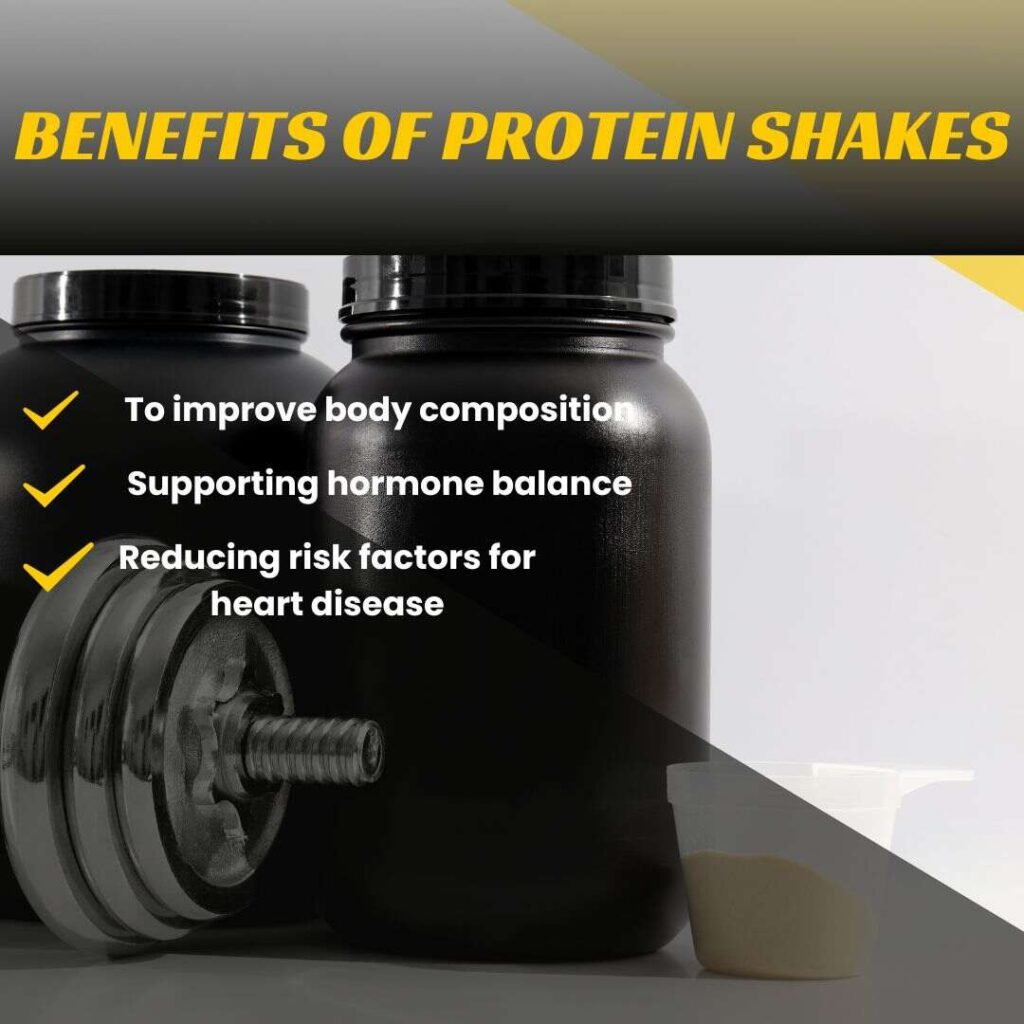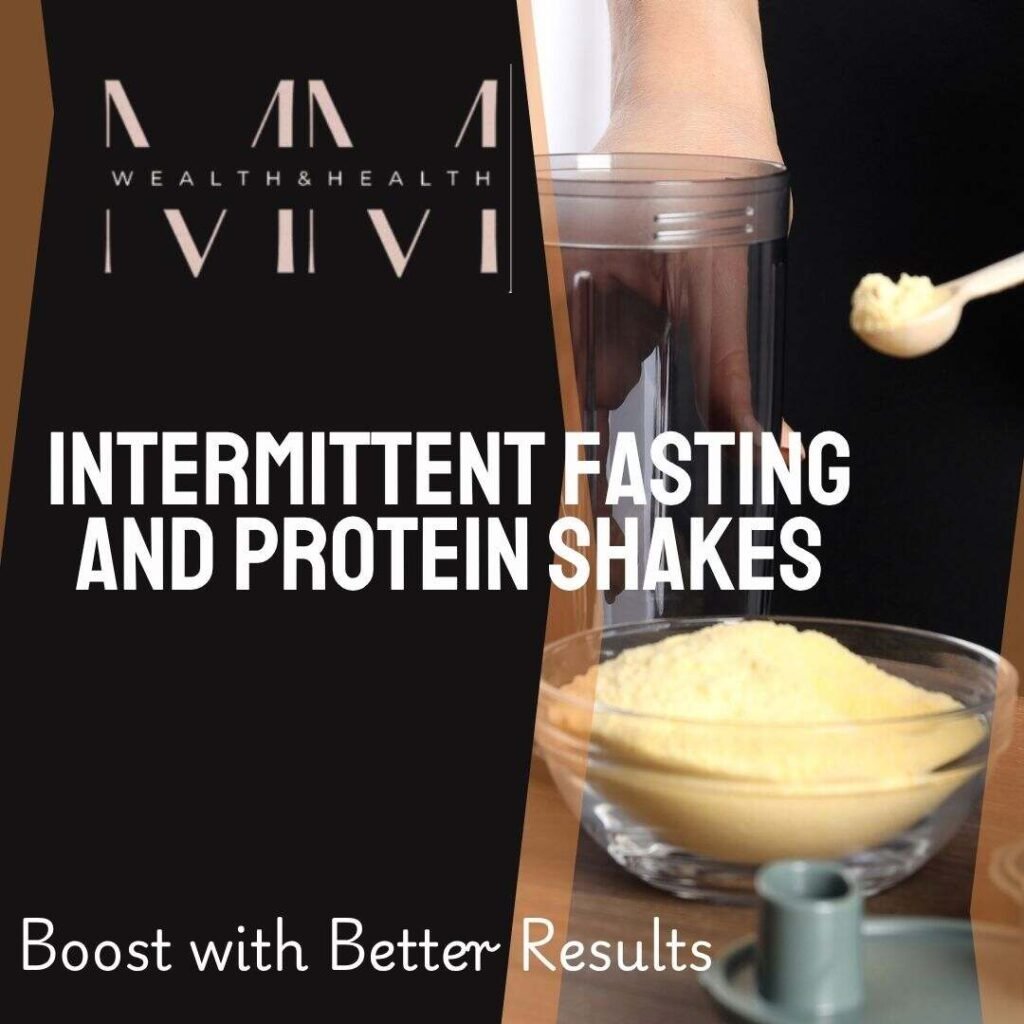Fasting with shakes
Intermittent fasting and protein shakes have become two of the most talked-about tools in the world of fitness and nutrition. Whether your goal is fat loss, muscle maintenance, or improved metabolic health, combining these two strategies has proven to be both effective and efficient in recent years. But here’s the real question: Do they actually work better together, or could one cancel out the other?
If you’re following an intermittent fasting routine and wondering when, or even if, you should include protein shakes in your eating plan, it’s best to get a clear understanding. This pairing has sparked many debates: Should you break your fast with a shake? Will it spike insulin levels? Can you use it as a full meal replacement? And more importantly, will it help you reach your weight loss goals while preserving lean muscle mass?

This guide cuts through the noise. We’ll explore the science, practical tips, and real-world strategies to show how protein shakes can complement your intermittent fasting plan, helping you stay energized, maintain muscle, and hit your fitness goals more effectively.
“A smart shake, taken at the right time, doesn’t break your progress; it fuels it. Done right, it’s not just a meal; it’s momentum.”
Intermittent fasting and protein shakes
Intermittent fasting is a dietary approach where you alternate between periods of fasting, also called a fasted state, and periods of eating, usually within a set feeding window. Instead of focusing on what you eat, intermittent fasting focuses on when you eat. It could be through the 16/8 method (fast for 16 hours, eat in an 8-hour window), alternate-day fasting, or other variations. Whatever the method, the idea is simple: give your body a break from constant digestion so it can reset, heal, and tap into its fat stores as an energy source.
Now, you might wonder, why protein shakes during intermittent fasting?

During any caloric restriction, it’s crucial to maintain adequate protein intake to prevent muscle loss. That’s where protein shakes come in. They’re packed with high-quality protein, rich in essential amino acids, and help support muscle repair, boost muscle protein synthesis, and preserve lean body mass. Whether you’re working out or simply aiming for better health, protein shakes are a convenient way to nourish your body without prepping elaborate meals. Many people also use them as meal replacements, especially when transitioning from a fast into their eating window.
Adding protein shakes isn’t just a fitness trend; it’s a smart, science-backed move to complement your fasting lifestyle and ensure your body gets exactly what it needs.
The Science-Backed Synergy – How Protein Shakes Amplify Intermittent Fasting Results
Intermittent fasting isn’t just a passing trend; it’s an eating pattern that has stood the test of time. What makes it so effective? It’s simple: you give your body a short period to rest from constant food intake, allowing it to shift into a natural fat-burning mode. Pair that with a high-protein diet, and you’ve got a system that supports not just fat loss, but also strength, focus, and long-term health.
One of the most powerful tools to enhance your fasting results is something surprisingly simple: protein shakes. More specifically, it’s a concept called protein pacing, spreading your high-quality protein evenly across your eating hours, based on your individual needs.

When done right, this combination delivers numerous health benefits. From improving body composition to supporting hormone balance, and even reducing risk factors for heart disease, this synergy is more than just about physique; it’s about complete well-being.
Protein Timing & Feeding Windows – The Best Times That Make the Difference
One of the benefits of intermittent fasting is the flexibility it offers. There are different ways to structure your feeding window, but what’s important is when and how you reintroduce nutrients, especially protein.
Research shows that consuming protein drinks like a shake right after your fast can kick-start muscle protein synthesis, increase energy levels, and enhance insulin sensitivity. This is especially helpful if you work out in a fasted state. By timing your first shake just after your fasting window ends, you’re giving your body exactly what it needs, without spiking insulin unnecessarily.
And no, this doesn’t mean you need to rely on shakes alone. Your shake can be part of a larger healthy diet filled with high-protein foods like eggs, lentils, chicken, or even a tablespoon of peanut butter blended into your smoothie. You can also explore protein supplements like whey isolate or plant-based options to meet your caloric intake goals without overeating.

So, what are the best times for a protein shake?
- Right after your feeding window opens
- After a workout (especially in a fasted state)
- As a small meal or meal replacement shake in the late afternoon to curb hunger and support recovery
“Break your fast with 25g of protein, and you switch your body from fat-burning mode to muscle-building mode without spiking insulin.”
This structure creates a great way to keep your food intake balanced, protein spaced, and digestion gentle, without derailing your fast.
Intermittent Fasting + Protein Shake Game Plan – A Day That Works
If you’re looking for a simple, real-world routine to follow, here’s an example that combines the benefits of fasting with smart protein pacing and nutrient-dense meals. It’s practical, flexible, and fits most lifestyles.
| Time | What You’re Doing | Protein + Calorie Notes |
|---|---|---|
| 7:00 AM | Black coffee or water | Keeps you in a fasted state, no caloric intake yet |
| 12:00 PM | Breakfast with a protein shake | 25–30g of high-quality protein, plus some essential nutrients |
| 2:30 PM | Balanced lunch | Include lean protein, healthy fats, whole grains, and maybe some peanut butter for flavor and healthy calories |
| 5:30 PM | An optional protein drink or snack | Helps meet your protein pacing goal, especially on workout days |
| 7:00 PM | Final meal in the feeding window | Light dinner with plant-based protein, vegetables, and a touch of healthy fats to finish strong |
This intermittent fasting routine isn’t about perfection; it’s about consistency. Even with a short period of commitment each day, you’ll begin to see the lasting benefits of intermittent fasting unfold: clearer focus, improved energy, and a stronger, leaner body that runs on real nourishment.
“Even if you only eat twice a day, protein shakes help you hit your targets, curb cravings, and stay on course, even on your busiest days.”
Tips to Nail the Routine
- Choose your protein powder: whey, plant‑based, or egg whites, depending on personal preferences and dietary protein needs.
- Watch artificial sweeteners; some can spike cravings.
- Track overall protein intake: aim for ~1.6–2.2 g/kg body weight to preserve muscle during caloric restriction.
- Adjust the eating period schedule and activity levels based on your individual goals and lifestyle.
Choosing the Best Protein Shake for Fasting
If you’re new to fasting, figuring out which protein shake works best can feel confusing. There are so many options out there, and not all of them are good for your goals. Some are packed with junk ingredients, while others might be too low in nutrients to do much. But here’s what you have to know: choosing the right one is pretty simple, especially once you know what to look for.

When you’re following an intermittent fasting routine, your body spends a good number of hours in a fasted state. That means it’s not just ready to eat, it’s ready to absorb. And what it absorbs first matters. That’s why breaking your fast with a high-quality protein source can make a huge difference.
“After fasting, your body is like a sponge; give it fast-digesting, high-quality protein and it absorbs every gram like gold.”
Why Protein Shakes Work So Well After a Fast
One of the best things you can give your body when your feeding window opens is a protein shake, especially one made with whey protein or another fast-digesting option. These are quickly absorbed and rich in essential amino acids, which are crucial for muscle repair, energy, and even appetite control.
Think about it: your body’s been running on empty. Now it needs fuel, but not just any fuel; it needs nutrients that rebuild and recharge. A protein shake right after your fast (or post-workout) helps your muscles bounce back, supports recovery, and even helps you feel more satisfied, so you’re not raiding the fridge for snacks 30 minutes later.

And don’t worry, you don’t need too much protein in one go. Around 20–30 grams per serving is plenty to get all the benefits without overwhelming your system.
What to Look for in a Fasting-Friendly Protein Shake
So, how do you choose the best protein shake? Here’s your cheat sheet:
- A clean, high-quality protein source with all essential amino acids
- Around 20–30g of protein per serving—no need to overload with much protein at once
- Stay away from shakes that are high in sugar or loaded with artificial sweeteners.
- A bit of healthy fats or fiber can help if you want something that keeps you full longer.
These small details go a long way. A good protein shake can either feel like a boost or a belly bomb. The goal is to nourish your body, not spike it with junk.
Shake Types – Quick, Real-Life Comparison
Here’s a breakdown of the most common shake types and why each one might (or might not) fit your fasting plan:
| Shake Type | Protein per Scoop | Calories | Why It’s Great |
|---|---|---|---|
| Whey protein isolate | 25–30g | 100–120 | Super fast-digesting, great for muscle repair, ideal for breaking your fast |
| Plant-based blend | 20–25g | 120–150 | Vegan-friendly, whole-food sourced, easy on the gut |
| Egg white protein | 20g | 90–110 | Low calorie, allergen-friendly, minimal additives |
| Meal replacement shakes | 15–20g | 200–250 | Full of balanced macros, vitamins & minerals—perfect for a full meal |
| Protein water | 10–15g | 50–60 | Ultra-light, refreshing, great as a sip during your feeding window |
“Not all shakes are created equal. Choose clean, complete proteins, without added junk, and your fast becomes fuel, not fluff.”
To make a better choice of Protein shakes, you should read this link, where you can find a list of the best protein powder. The 5 Best Protein Powders for Intermittent Fasting
Extra tip to remember
If you’re breaking your fast after a workout, go for whey protein isolate; it’s light, easy to digest, and does wonders for recovery. On the other hand, if your shake is your full lunch or dinner (maybe you’re in a rush or just not super hungry), a meal replacement shake is your best bet. Look for one that includes healthy fats, fiber, and micronutrients to hold you over until your next eating opportunity.
And yes, protein water is a thing. It’s not going to replace a full meal, but it’s awesome if you want something super light that still gives you a protein hit, especially mid-feeding window.
Also, don’t be afraid to customize. Want extra flavor or satiety?
Add a spoonful of almond or peanut butter. Just make sure it fits into your overall caloric intake and goals.
1. Can I drink protein shakes during the fasting period?
Not during a strict fasted state, as they contain calories. But during your fasting window, a protein shake break after your fast can support muscle preservation.
2. How much protein is enough for fasting?
Aim for 1.6–2.2g per kg of body weight daily. Split it up to boost muscle protein synthesis and avoid too much protein at once.
3. What if I use shakes instead of whole foods?
Shakes work well as meal replacements, but whole foods offer healthy fats, fiber, and essential nutrients important for overall health.
4. Are there any potential benefits or downsides?
Benefits: supports fat burning, insulin sensitivity, muscle preservation, and is a convenient way to structure meals.
Downsides: Overreliance on shakes may lead to missing vital micronutrients and dietary variety.
5. Is it okay to break my fast with a protein shake?
Yes! Drink it at the start of your eating window to support muscle repair, muscle maintenance, and reduce hunger.
6. What’s the best time to drink protein shakes during intermittent fasting?
The best times are right after your fast ends or post-workout, during your feeding window, to support muscle repair and energy levels.
7. Can protein shakes be part of a high-protein diet?
Yes! They’re an easy way to boost food intake, especially if you struggle to meet your high-protein diet goals with meals alone.
8. Are protein drinks good for heart health?
When chosen wisely (low sugar, no artificial sweeteners), protein drinks can be part of a healthy diet and may support long-term protection against heart disease.
Personalizing for Your Goals
Your eating pattern should reflect what you’re aiming for, whether it’s weight loss, muscle gain, or just better energy. Fasting does not give similar results to all, and neither do protein shakes.
If your goal is weight loss, start by focusing on a consistent calorie deficit. The 16/8 method works well for many. Two protein shakes during your feeding window, followed by a balanced meal, can help you shed extra fat without feeling starved.
Trying to maintain or build lean muscle? You’ll need more structure. Make sure your feeding windows are kept frequent, especially around workouts. This helps with protein pacing, giving your muscles steady support throughout the day.
And if you’re vegetarian or vegan, no worries, just look for plant-based proteins like pea, hemp, or rice blends. They’re a great way to meet your protein needs without compromising your lifestyle.
The bottom line? Match your fasting and shake routine to your personal lifestyle, schedule, and fitness level. That’s the sweet spot.
Precautions & Professional Input
Before you dive all-in, it’s important to make sure your plan supports your body, not just your goals. First, always cover your nutritional requirements. That means not skipping out on essential nutrients like fiber, vitamins, and healthy fats, especially if you’re using shakes as meal replacements.
If you have any health concerns, like insulin sensitivity issues, kidney conditions, or food allergies, it’s smart to talk to a registered dietitian. They can help tailor your fasting and protein intake to suit your individual needs.
And don’t forget, just because a dietary approach works for others doesn’t mean it will feel right for you. Listen to your body. Some people thrive on longer fasts and fewer meals, while others need more variety or shorter fasting windows. The key is sustainability.
“Fasting is not suitable for all; it varies. What fuels one body may drain another, respect your own rhythm.”
Power of Fasting – Designed for Women, Backed by Science
This empowering guide is your go-to resource for sustainable weight loss, hormone balance, and a faster metabolism, without extreme diets or counting calories. Packed with expert tips and real-life strategies, it helps you take control of your body in a way that truly works. If you’re ready to feel stronger, healthier, and more confident, this is the book that will change everything.
Grab your copy on Amazon and start your transformation today.
Conclusion
Combining intermittent fasting and protein shakes is more than a trend. It’s an effective strategy for those chasing muscle preservation, fat loss, and better metabolic health. With the right protein shake timing, smart dosing, and a balanced diet, you’re on track to hit those fitness goals, maintain energy, and build a healthier lifestyle, with less hype, more substance.
Start small: pick a fasting regimen that fits your lifestyle, choose a clean, high‑quality shake, and make it part of your feeding window. You’ll find it’s a surprisingly easy way to stay consistent, energized, and on track with your weight loss goals, without sacrificing deliciousness or your sanity.
“Fasting fuels the discipline. Protein powers the results. This isn’t just about weight loss, it’s about owning your energy.”
Not sure which protein shake actually supports your fasting goals?
With so many options out there, it’s easy to choose the wrong one. But the right shake can make all the difference, helping you break your fast, stay full longer, and protect your muscles while losing fat.
We’ve narrowed it down to the top protein powders that work best with intermittent fasting. No unnecessary details, just real choices that work.
Read our guide to the best protein shakes for intermittent fasting and make your next fast smarter, not harder.
Explore the top protein shakes now
Boldly ease into your fasting window. Break it with a quality protein shake. Nurture your muscles, boost your energy, and watch your body composition improve, all while enjoying a sane, science-backed approach that works.



